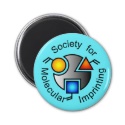|
|
Reference type: Journal
Authors: Szabelski P, Kaczmarski K, Cavazzini A, Chen YB, Sellergren B, Guiochon G
Article Title: Energetic heterogeneity of the surface of a molecularly imprinted polymer studied by high-performance liquid chromatography.
Publication date: 2002
Journal: Journal of Chromatography A
Volume: 964
Issue: (1-2)
Page numbers: 99-111.
DOI: 10.1016/S0021-9673(02)00587-3
Abstract: The influence of thermal annealing on the surface homogeneity of a polymer imprinted against L-phenylalanine anilide (LPA) was examined using high-performance liquid chromatography (HPLC) for the measurement of the adsorption isotherms. The isotherms obtained for LPA and for its enantiomer, D- phenylalanine anilide (DPA) were fitted to the Freundlich (F) equation which accounts for the energetic heterogeneity of the surface with a separate parameter. Changes in the adsorptive properties of the polymer produced by thermal annealing were deduced by comparing the heterogeneity parameters given by the nonlinear regression. These changes were also illustrated by deriving the isosteric heats of adsorption as functions of the amounts adsorbed and by calculating the associated affinity distributions. This latter technique involves an application of the affinity spectrum (AS) combined with the F adsorption model. The plausibility and accuracy of the combination is discussed. It is shown that the derivation of the amplitudes of the affinity distributions from the F parameters is inaccurate, making difficult the proper estimate of the changes in the total population of adsorption sites. In contrast, the AS method gives correct estimates of the parameter that characterizes the slope of the affinity distributions. The results derived from the three sets of results (F model parameters, isosteric heats of adsorption, AS+F method) show consistently that annealing reduces the energetic heterogeneity of the polymer surface for both LPA and DPA. In practice, however, the improvement of the polymer performance in HPLC is relatively limited. (C) 2002 Elsevier Science B.V. All rights reserved
|


 SMI keychain blue
SMI keychain blue







 Good morning caffeine apron
Good morning caffeine apron







 SMI magnet blue
SMI magnet blue






